|
(11) | EP 1 044 193 B1 |
| (12) | EUROPEAN PATENT SPECIFICATION |
|
|
| (54) |
PROCESS FOR PREPARING TRIAZOLE ANTIMYCOTIC COMPOUNDS VERFAHREN ZUR HERSTELLUNG VON ANTIMYKOTISCHEN TRIAZOL VERBINDUNGEN PROCEDE DE PREPARATION DE COMPOSES TRIAZOLE ANTIMYCOSIQUES |
|
|
|||||||||||||||||||||||||||||||||||
| Note: Within nine months from the publication of the mention of the grant of the European patent, any person may give notice to the European Patent Office of opposition to the European patent granted. Notice of opposition shall be filed in a written reasoned statement. It shall not be deemed to have been filed until the opposition fee has been paid. (Art. 99(1) European Patent Convention). |
[0001] The present invention refers to a process for the preparation of azole compounds endowed with antimycotic activity.
[0002] The compounds of formula I
wherein R1 is chlorine, fluorine or trifluoromethyl;
R2 is hydrogen, chlorine, fluorine or trifluoromethyl;
R3 is C1-4 alkyl; and
R4 is a C1-5 polyfluoroalkyl group containing at least two fluorine atoms and optionally other halogen atoms selected from chlorine and bromine;
and their salts with pharmaceutically acceptable acids, are known as antimycotic and antifungal agents.
[0003] The patent application WO 97/31903 (in the Applicant's name) shows a class of compounds which those of formula I above fall within, as broad spectrum antimycotics against human and animal pathogenic fungi. Such compounds are obtained from the intermediate of formula VII
wherein R1, R2 and R3 are as defined above, which reacted with the suitable polyfluoroalkyl derivative provides the desired compound of formula I.
[0004] It has been now found a new method for preparing the compounds of formula VII constituting an alternative to the synthetic routes described in the above cited prior art.
[0005] Therefore the present invention refers to a method for preparing compounds of formula VII as illustrated hereinbelow.
[0006] The synthesis of the compounds I according to the invention starts from the olefin of formula II
wherein R1 and R2 are as defined above, and R is hydrogen or a protecting group for the hydroxy moiety. This compound is described and claimed per se in the co-pending patent application filed in the same date of the present one by the Applicant. It is epoxidized, for example according to what described in the patent EP-0 046 033 (in the name of Standford University) which uses titanium alcoholate in the presence of a suitable derivative of tartaric acid and of an organic hydroperoxide, for example tert.butyl- or cumyl-hydroperoxide, or according to what taught in Synthesis, 1986, page 89. It is thus obtained the oxirane of formula III
wherein R, R1 and R2 are as defined above, which, treated with (C1-4)alkyl-magnesium halide in the presence of copper(I) iodide, prepared according to what described in Organocopper Reagents: a practical approach, page 39, ed. R.I.K Taylor, provides the triol of formula IV
wherein R, R1, R2 and R3 are as defined above.
[0007] The triol of formula IV is treated with a sulfonic acid chloride, such as, for example methan-sulfonyl-chloride or tosyl chloride, or with a halogenating agent such as, for example, phosphorous tribromide, thionyl chloride or phosphorous pentachloride and, sequentially, with a strong base, for example NaOH, to give the compound of formula V
wherein R1, R2 and R3 are as defined above, and Lg is halogen or a OSO2RIV group wherein RIV is a (C1-4)alkyl or an optionally methyl-substituted phenyl group, which subdued to a reac tion for substituting the leaving group Lg according to known methods gives the compound of formula VI
wherein R1, R2 and R3 are as defined above. This is treated with 1,2,4-triazole in basic medium to give the desired compound of formula VII.
[0008] EP 0 315 946 discloses the preparation of fungicide azolyl derivatives and EP 0 667 346 describes the preparation of azole antifungal agents.
Example 1
Synthesis of (E)-(2R,3R)-2-(2,4-dichlorophenyl)-2,3-dihydroxymethyl-oxirane
[0010] A suspension of previously ground 4Å molecular sieves (2.4 g) and (-)-diethyl tartrate (3.4 g; 16.3 mmoles) in methylene chloride (150 ml) was cooled to -20°C under nitrogen, then treated with titanium isopropylate (3.9 g; 13.6 mmoles) and (E)-2-(2,4-dichlorophenyl)-buten-1,4-diol (3.2 g; 13.6 mmoles). Keeping the temperature at -20°C 2M tert.-butyl hydroperoxide in methylene chloride (13.5 ml; 27 mmoles) was slowly added in about 30 minutes and it was stirred at -20°C for further 20 hours. Then 10% sodium sulfite (35 ml; 28 mmoles) was added, the phases were separated and the aqueous one extracted with methylene chloride (30 ml). The joined organic phases were filtered on celite cake and concentrated to half the volume. It was cooled to 0°C, a 30% solution of sodium hydroxide (20 ml) saturated with NaCl was added. The stirring was kept on for 1 hour. The mixture was acidified with 50% H2SO4, and the organic phase was dried to give 2.9 g of crude. After purification by flash chromatography (SiO2; hexane/ethyl acetate/methanol 70/30/2) 2.63 g of (E)-(2R,3R)-2-(2,4-dichlorophenyl)-2,3-dihydroxymethyl-oxirane were obtained (yield 78%; enantiomeric excess: 97.8%).
Example 2
Synthesis of (E)-(2R,3R)-2-(2,4-dichlorophenyl)-2,3-dihydroxymethyl-oxirane
[0011] Starting from 1 g (4.18 mmoles) of (E)-2-(2,4-dichlorophenyl)-buten-1,4-diol and operating as described in example 1, but using (-)diethyl tartrate and titanium isopropylate in catalytic amounts with respect to (E)-2-(2,4-dichlorophenyl)-buten-1,4-diol, respectively 6% and 5% molar, and with a longer reaction time (about 70 hours), 800 mg of (E)-(2R,3R)-2-(2,4-di-chlorophenyl)-2,3-dihydroxymethyl-oxirane were obtained (yield 76.2%; enantiomeric excess 68%) after purification by column chromatography (SiO2; ethyl acetate:petrolatum 1:1).
1H-NMR (300 MHz, DMSO, δ=ppm, J=Hz): 2.74 (ddd, 1H, J=12.2, J=7.6, J=5.6); 3.45 (dd, 1H, J=7.6, J=2.5); 3.54 (dd, 1H, J=12.6, J=6.5); 3.58 (ddd, 1H, J=12.2, J=2.5, J=5.6); 3.88 (dd, 1H, J=12.6, J=6.5); 4.89 (t, 1H, J=5.6); 5.06 (t, 1H, J=6.5); 7.38 (d, 1H, J=8.3); 7.45 (dd, 1H, J=8.3, J=2.0); 7.6 (d, 1H, J=2.0).
Example 3
Synthesis of (2R,3S)-2-(2,4-dichlorophenyl)-3-methyl-1,2,4-trihydroxy-butane
[0012] A suspension of copper(I) iodide (2.75 g; 14.45 mmoles) in dry THF (360 ml) and cooled to -10°C was added with a solution of 3M methyl-magnesium chloride in THF (48.2 ml; 144.5 mmoles) then dropwise added, in about I hour, with a solution of (E)-(2R,3R)-2-(2,4-dichlorophenyl)-2,3-dihydroxymethyl-oxirane obtained as described in example 1 or 2 (6 g; 24.1 mmoles) keeping the temperature at -10°C. The temperature was left to raise up to +5°C and it was stirred for 120 hours. The mixture was poured into a saturated solution of ammonium chloride (350 ml), the phases were separated and the aqueous one extracted with ether (100 ml). The organic phases were washed with a saturated solution of NaCl (200 ml), dried over dry Na2SO4 and evaporated. The crude was purified by flash chromatography (SiO2; n-heptane/ethyl acetate 60/40) to give 3.75 g of (2R,3S)-2-(2,4-dichlorophenyl)-3-methyl-1,2,4-tri-hydroxy-butane (yield 58%; enantiomeric excess: 97%).
1H-NMR (300 MHz, DMSO, δ=ppm, J=Hz): 0.55 (d, 3H, J=7.00); 2.47 (ddq, 1H, J=6.30, J=4.80, J=7.00); 3.38 (ddd, 1H, J=11.00, J=4.84, J=6.30); 3.68 (ddd, 1H, J=11.00, J=4.80, J=4.76); 3.86 (dd, 1H, J=11.35, J=4.39); 4.18 (dd, 1H, J=11.35, J=6.23); 4.58 (dd, 1H, J=6.23, J=4.39); 4.70 (dd, 1H, J=4.84, J=4.76); 5.00 (s,1H); 7.38 (dd,1H,J=8.80,J=2.20); 7.47 (d,1H,J=2.20); 7.76 (d,1H,J=8.80).
Example 4
Synthesis of (2R)-2-[(2R)-2-(2,4-dichlorophenyl)-oxiranyl]-1-propyl methansulfonate
[0013] A solution of (2R,3S)-2-(2,4-dichlorophenyl)-3-methyl-1,2,4-trihydroxy-butane obtained as in example 3 (1 g; 3.77 mmoles) in pyridine (20 ml) was added, under stirring in about 30 minutes at a temperature of 15°C, with methansulfonyl chloride (0.91 g; 7.92 mmoles), then the stirring was kept on at 15°C for 20 hours. The reaction mixture was added with a 10N solution of sodium hydroxide (2 ml; 20 mmoles), and the whole was heated to 35°C under stirring for 1 hour. Then it was poured into ice (about 80 g), acidified with 50% H2SO4 (about 35 ml) and twice extracted with methylene chloride (30 ml). The joined organic phases were dried. The crude (1.23 g) was purified by flash chromatography (SiO2; n-heptane/ethyl acetate 85/15) to give 0.96 g of (2R)-2-[(2R)-2-(2,4-dichlorophenyl)-oxiranyl]-1-propyl methansulfonate (yield 78%).
1H-NMR (300 MHz, DMSO, δ=ppm, J=Hz): 0.94 (d, 3H, J=7.03); 2.50 (ddq, 1H, J=6.40, J=6.10, J=7.00); 2.82 (d, 1H, J=4.40); 3.19 (s, 3H); 3.24 (d, 1H, J=4.40); 4.1 (dd, 1H, J=10.25, J=6.10); 4.12 (dd, 1H, J=10.25, J=6.40); 7.46 (m, 3H); 7.66 (d, 1H, J=1.65).
Example 5
Synthesis of (2R)-2-[(2R)-2-(2,4-dichlorophenyl)-oxiranyl]-1-propanol
[0014] A solution of (2R)-2-[(2R)-2-(2,4-dichlorophenyl)-oxiranyl]-1-propyl methansulfonate obtained as described in example 4 (0.9 g; 2.77 mmoles) in DMF (12 ml) was added with potassium acetate (710 mg; 7.25 mmoles) and tetrabutylammonium iodide (45 mg; 0.14 mmoles) then heated to 75°C for 4 hours. Another portion of tetrabutylammonium iodide (45 mg; 0.14 mmoles) was added and it was stirred at 75°C for total 18 hours. After cooling to 20°C, water (1 ml) and 30% NaOH (0.4 ml; 4 mmoles) were added and the stirring was kept on at 20°C for 1 hour. It was diluted with water (50 ml) and extracted with ether (20 ml). After separation of the phases it was anhydrified over dry Na2SO4 and dried. The crude (0.7 g) was purified by flash chromatography (SiO2; hexane/ethyl acetate 85/15) to give 0.57 g of (2R)-2-[(2R)-2-(2,4-dichlorophenyl)-oxiranyl]-1-propanol (yield 83%).
1H-NMR (300 MHz, DMSO, δ=ppm, J=Hz): 0.83(d,3H, J=6.80); 2.15(ddq,1H, J=6.60, J= 6.10, J=6.80); 2.72(d,1H, J=4.70); 3.17(ddd 1H, J=11.00, J=6.60, J=5.30); 3.22(d,1H, J= 4.70); 3.38(ddd,1H, J=11.00, J=6.10, J=5.30); 4.8(t, 1H, J=5.30); 7.43(s, 2H); 7.61(s, 1H).
Example 6
Synthesis of (2R-3S)-2-(2,4-dichlorophenyl)-3-methyl-1-(1H-1,2,4-triazol-1-yl)-2,4-butandiol
[0015] A solution of 1,2,4-triazole (0.65 g; 9.4 mmoles) in DMF (7 ml) was portionwise added, at 15-20°C, with 60% NaH (370 mg; 9.4 mmoles). At the end of the addition, the stirring was kept on until total dissolution. A solution of (2R)-2-[(2R)-2-(2,4-dichlorophenyl)-oxiranyl]-1-propanol obtained as described in example 5 (0.62 g; 2.34 mmoles) in DMF (2.5 ml) was added and heated to 125°C for 2 hours. The mixture was cooled, diluted with water (50 ml) and twice extracted with ethyl acetate (30 ml). The organic phases were washed with water (30 ml), anhydrified over dry Na2SO4, then dried. The crude (0.7 g) was purified by flash chromatography (SiO2; hexane/ethyl acetate/methanol 70/30/10) to give 0.57 g of (2R,3S)-2-(2,4-di-chlorophenyl)-3-methyl-1-(1H-1,2,4-triazol-1-yl)-2,4-butandiol (yield 77%), then crystallized from isopropyl ether/toluene 8/2. m.p. 115-116°C; enantiomeric excess: 97%.
1H-NMR (300 MHz, DMSO, δ=ppm, J=Hz): 0.56(d, 3H, J=7.00); 2.86(ddq, 1H, J=5.60, J=5.30, J=7.00); 3.58(ddd, 1H, J=11.00, J=5.30, J=5.00); 3.83(ddd, 1H, J=11.00, J=5.60, J=5.00); 4.78(d, 1H, J=4.60); 5.05 (t, 1H, J=5.00); 5.2 (d, 1H, J=4.60); 5.63 (s, 1H); 7.2 (dd, 1H, J=8.60, J=2.20); 7.36 (d, 1H, J=8.60); 7.47 (d, 1H, J=2.20); 7.7 (s, 1H); 8.25 (s, 1H).
1. Process for the preparation of a compound of formula VII

wherein R1 is chlorine, fluorine or trifluoromethyl;
R2 is hydrogen, chlorine, fluorine or trifluoromethyl;
R3 is C1-4 alkyl; characterized in that an olefin of formula II

wherein R1 and R2 are as defined above, and R is hydrogen or a protecting group of the hydroxy moiety, is epoxidized to give the oxirane of III

wherein R, R1 and R2 are as defined above, which, treated with (C1-4)alkyl-magnesium halide in the presence of copper(I) iodide gives a triol of formula IV

wherein R, R1, R2 and R3 are as defined above; and characterized in that the triol of formula IV is treated with a sulfonic acid chloride or with a halogenating agent, then with a strong base, to give the compound of formula V

wherein R1, R2 and R3 are as defined above, and Lg is halogen or a OSO2RIV group wherein RIV is a (C1-4)alkyl group or an optionally methyl-substituted phenyl group, which is subdued to a reaction for substituting the Lg leaving group thus yielding the compound of formula VI

wherein R1, R2 and R3 are as defined above, which is treated with 1,2,4-triazole in basic medium and gives the compound of formula VII
wherein R1 is chlorine, fluorine or trifluoromethyl;
R2 is hydrogen, chlorine, fluorine or trifluoromethyl;
R3 is C1-4 alkyl; characterized in that an olefin of formula II
wherein R1 and R2 are as defined above, and R is hydrogen or a protecting group of the hydroxy moiety, is epoxidized to give the oxirane of III
wherein R, R1 and R2 are as defined above, which, treated with (C1-4)alkyl-magnesium halide in the presence of copper(I) iodide gives a triol of formula IV
wherein R, R1, R2 and R3 are as defined above; and characterized in that the triol of formula IV is treated with a sulfonic acid chloride or with a halogenating agent, then with a strong base, to give the compound of formula V
wherein R1, R2 and R3 are as defined above, and Lg is halogen or a OSO2RIV group wherein RIV is a (C1-4)alkyl group or an optionally methyl-substituted phenyl group, which is subdued to a reaction for substituting the Lg leaving group thus yielding the compound of formula VI
wherein R1, R2 and R3 are as defined above, which is treated with 1,2,4-triazole in basic medium and gives the compound of formula VII
2. Process for the preparation of a compound of formula I

wherein R1 is chlorine, fluorine or trifluoromethyl;
R2 is hydrogen, chlorine, fluorine or trifluorumethyl;
R3 is C1-4 alkyl; and
R4 is a C1-5 polyfluoroalkyl group containing at least two fluorine atoms and optionally other halogen atoms selected from chlorine and bromine;
and their salts with pharmaceutically acceptable acid, characterized in that an olefin of formula II

wherein R1 and R2 are as defined in claim 1, and R is hydrogen or a protecting group of the hydroxy moiety, is epoxidized to give the oxirane of III

wherein R, R1 and R2 are as defined in claim 1, which, treated with (C1-4)alkyl-magnesium halide in the presence of copper(I) iodide gives a triol of formula IV

wherein R, R1, R2 and R3 are as defined in claim 1; and characterized in that the triol of formula IV is treated with a sulfonic acid chloride or with a halogenating agent, then with a strong base, to give the compound of formula V

wherein R1, R2 and R3 are as defined in claim 1, and Lg is halogen or a OSO2RIV group wherein RIV is a (C1-4)alkyl group or an optionally methyl-substituted phenyl group, which is subdued to a reaction for substituting the Lg leaving group thus yielding the compound of formula VI

wherein R1, R2 and R3 are as defined in claim 1, which is treated with 1,2,4-triazole in basic medium and gives the compound of formula VII

wherein R1, R2 and R3 are as defined in claim 1, which is reacted with the suitable polyfluoroalkyl derivative.
wherein R1 is chlorine, fluorine or trifluoromethyl;
R2 is hydrogen, chlorine, fluorine or trifluorumethyl;
R3 is C1-4 alkyl; and
R4 is a C1-5 polyfluoroalkyl group containing at least two fluorine atoms and optionally other halogen atoms selected from chlorine and bromine;
and their salts with pharmaceutically acceptable acid, characterized in that an olefin of formula II
wherein R1 and R2 are as defined in claim 1, and R is hydrogen or a protecting group of the hydroxy moiety, is epoxidized to give the oxirane of III
wherein R, R1 and R2 are as defined in claim 1, which, treated with (C1-4)alkyl-magnesium halide in the presence of copper(I) iodide gives a triol of formula IV
wherein R, R1, R2 and R3 are as defined in claim 1; and characterized in that the triol of formula IV is treated with a sulfonic acid chloride or with a halogenating agent, then with a strong base, to give the compound of formula V
wherein R1, R2 and R3 are as defined in claim 1, and Lg is halogen or a OSO2RIV group wherein RIV is a (C1-4)alkyl group or an optionally methyl-substituted phenyl group, which is subdued to a reaction for substituting the Lg leaving group thus yielding the compound of formula VI
wherein R1, R2 and R3 are as defined in claim 1, which is treated with 1,2,4-triazole in basic medium and gives the compound of formula VII
wherein R1, R2 and R3 are as defined in claim 1, which is reacted with the suitable polyfluoroalkyl derivative.
1. Verfahren zur Herstellung einer Verbindung mit der Formel VII
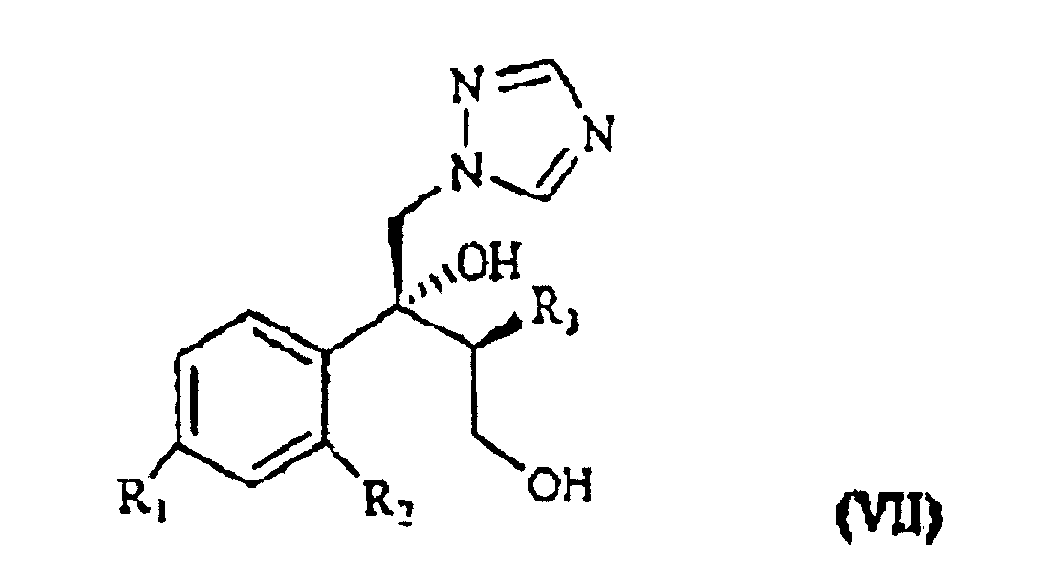
in der R1 Chlor, Fluor oder Trifluormethyl ist;
R2 Wasserstoff, Chlor, Fluor oder Trifluormethyl ist;
R3 C1- bis C4-Alkyl ist, dadurch gekennzeichnet, dass ein Olefin der Formel II

in der R1 und R2 wie oben definiert sind und R Wasserstoff oder eine Schutzgruppe für die Hydroxygruppe ist, unter Bildung des Oxirans III
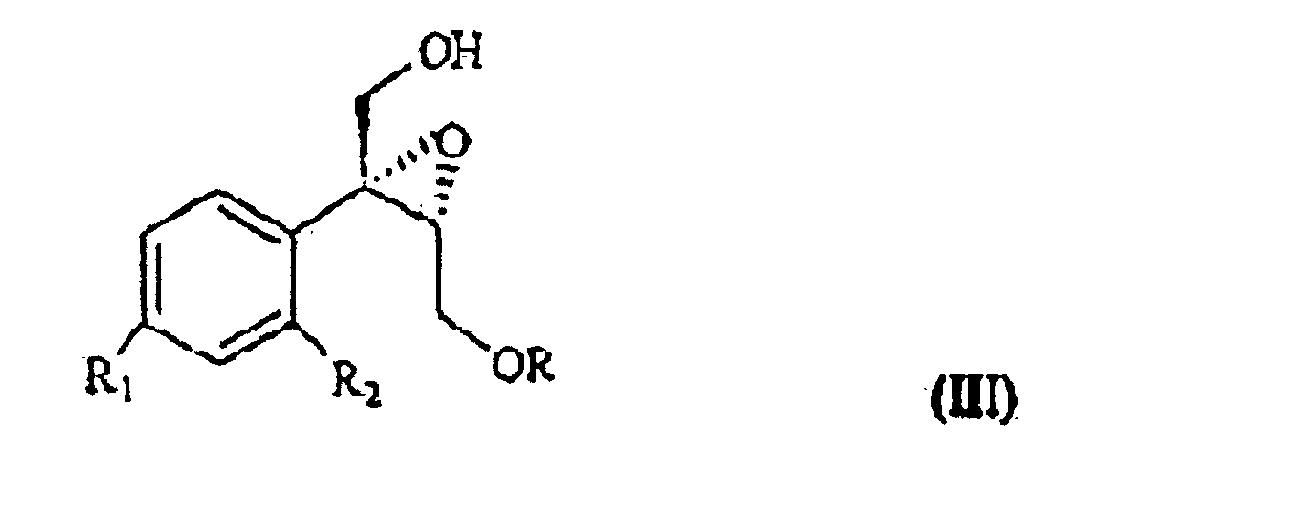
epoxidiert wird, wobei R, R1 und R2 wie oben definiert sind, das bei Behandlung mit (C1- bis C4)-Alkylmagnesiumhalogenid in Gegenwart von Kupfer(I)iodid ein Triol der Formel IV

ergibt, wobei R, R1, R2 und R3 wie oben definiert sind, und dadurch gekennzeichnet ist, dass das Triol der Formel IV mit einem Sulfonsäurechlorid oder mit einem Halogenierungsmittel, danach mit einer starken Base behandelt wird, um die Verbindung der Formel V

zu ergeben, wobei R1, R2 und R3 wie oben definiert sind und Lg Halogen oder eine OSO2RIV Gruppe ist, wobei RIV eine (C1- bis C4)-Alkylgruppe oder eine gegebenenfalls methylsubstituierte Phenylgruppe ist, die einer Reaktion zum Ersetzen der Lg-Abgangsgruppe unterzogen wird, was die Verbindung der Formel VI

ergibt, wobei R1, R2 und R3 wie oben definiert sind, die mit 1,2,4-Triazol in basischem Medium behandelt wird und die Verbindung der Formel VII ergibt.
in der R1 Chlor, Fluor oder Trifluormethyl ist;
R2 Wasserstoff, Chlor, Fluor oder Trifluormethyl ist;
R3 C1- bis C4-Alkyl ist, dadurch gekennzeichnet, dass ein Olefin der Formel II
in der R1 und R2 wie oben definiert sind und R Wasserstoff oder eine Schutzgruppe für die Hydroxygruppe ist, unter Bildung des Oxirans III
epoxidiert wird, wobei R, R1 und R2 wie oben definiert sind, das bei Behandlung mit (C1- bis C4)-Alkylmagnesiumhalogenid in Gegenwart von Kupfer(I)iodid ein Triol der Formel IV
ergibt, wobei R, R1, R2 und R3 wie oben definiert sind, und dadurch gekennzeichnet ist, dass das Triol der Formel IV mit einem Sulfonsäurechlorid oder mit einem Halogenierungsmittel, danach mit einer starken Base behandelt wird, um die Verbindung der Formel V
zu ergeben, wobei R1, R2 und R3 wie oben definiert sind und Lg Halogen oder eine OSO2RIV Gruppe ist, wobei RIV eine (C1- bis C4)-Alkylgruppe oder eine gegebenenfalls methylsubstituierte Phenylgruppe ist, die einer Reaktion zum Ersetzen der Lg-Abgangsgruppe unterzogen wird, was die Verbindung der Formel VI
ergibt, wobei R1, R2 und R3 wie oben definiert sind, die mit 1,2,4-Triazol in basischem Medium behandelt wird und die Verbindung der Formel VII ergibt.
2. Verfahren zur Herstellung einer Verbindung mit der Formel I
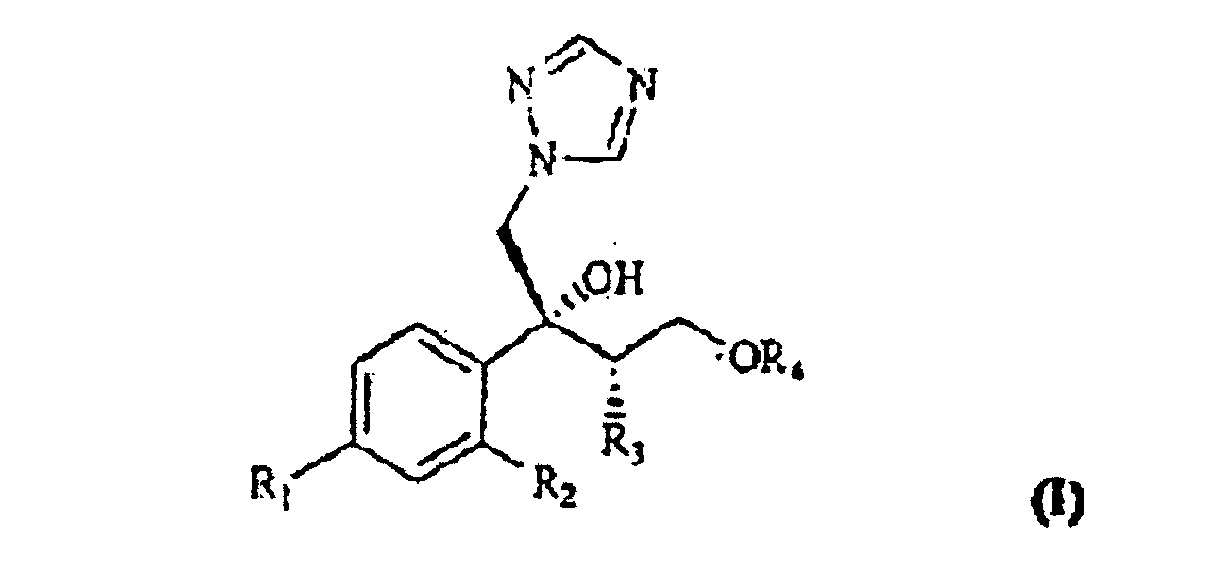
in der R1 Chlor, Fluor oder Trifluormethyl ist;
R2 Wasserstoff, Chlor, Fluor oder Trifluormethyl ist;
R3 C1- bis C4-Alkyl ist,
und R4 eine C1- bis C5-Polyfluoralkylgruppe ist, die mindestens zwei Fluoratome und gegebenenfalls andere Halogenatome ausgewählt aus Chlor und Brom enthält;
und ihrer Salze mit pharmazeutisch annehmbarer Säure, dadurch gekennzeichnet, dass ein Olefin der Formel II
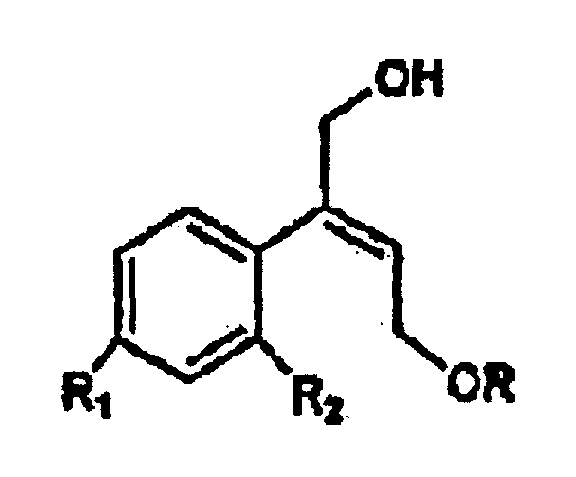
in der R1 und R2 wie oben definiert sind und R Wasserstoff oder eine Schutzgruppe für die Hydroxygruppe ist, unter Bildung des Oxirans III
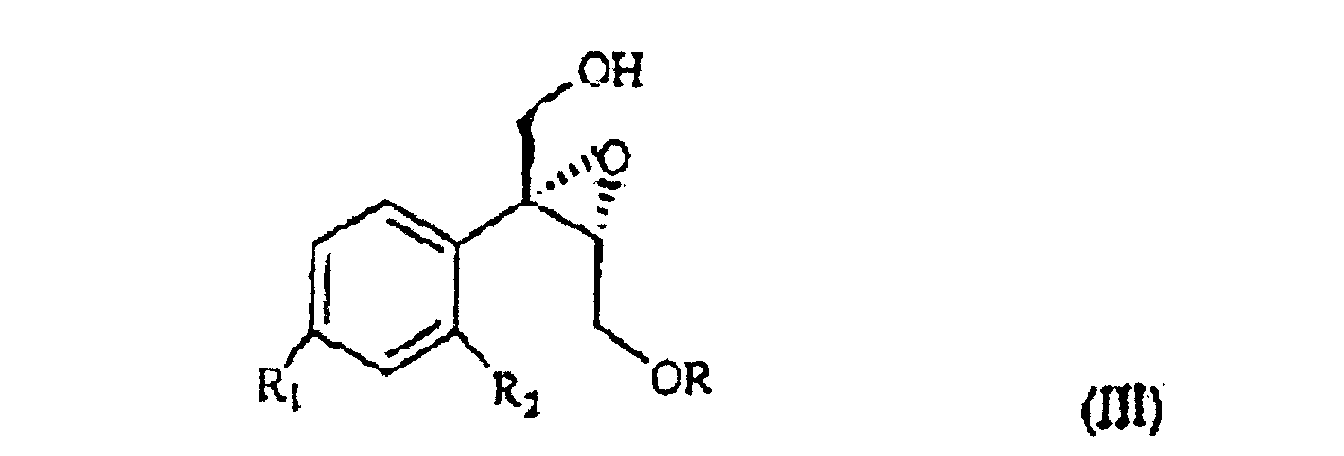
epoxidiert wird, wobei R, R1 und R2 wie in Anspruch 1 definiert sind, das bei Behandlung mit (C1- bis C4)-Alkylmagnesiumhalogenid in Gegenwart von Kupfer(I)iodid ein Triol der Formel IV

ergibt, wobei R, R1, R2 und R3 wie in Anspruch 1 definiert sind, und dadurch gekennzeichnet ist, dass das Triol der Formel IV mit einem Sulfonsäurechlorid oder mit einem Halogenierungsmittel, danach mit einer starken Base behandelt wird, um die Verbindung der Formel V

zu ergeben, wobei R1, R2 und R3 wie in Anspruch 1 definiert sind und Lg Halogen oder eine OSO2RIV Gruppe ist, wobei RIV eine (C1- bis C4)-Alkylgruppe oder eine gegebenenfalls methylsubstituierte Phenylgruppe ist, die einer Reaktion zum Ersetzen der Lg-Abgangsgruppe unterzogen wird, was die Verbindung der Formel VI

ergibt, wobei R1, R2 und R3 wie in Anspruch 1 definiert sind, die mit 1,2,4-Triazol in basischem Medium behandelt wird und die Verbindung der Formel VII
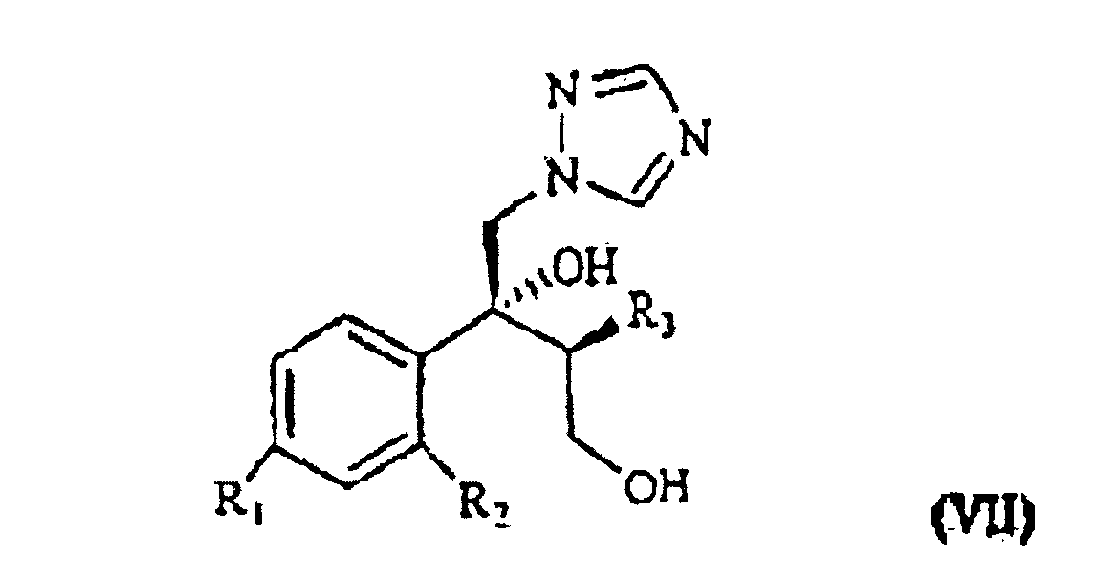
ergibt, in der R1, R2 und R3 wie in Anspruch 1 definiert sind, die mit dem geeigneten Polyfluoralkylderivat umgesetzt wird.
in der R1 Chlor, Fluor oder Trifluormethyl ist;
R2 Wasserstoff, Chlor, Fluor oder Trifluormethyl ist;
R3 C1- bis C4-Alkyl ist,
und R4 eine C1- bis C5-Polyfluoralkylgruppe ist, die mindestens zwei Fluoratome und gegebenenfalls andere Halogenatome ausgewählt aus Chlor und Brom enthält;
und ihrer Salze mit pharmazeutisch annehmbarer Säure, dadurch gekennzeichnet, dass ein Olefin der Formel II
in der R1 und R2 wie oben definiert sind und R Wasserstoff oder eine Schutzgruppe für die Hydroxygruppe ist, unter Bildung des Oxirans III
epoxidiert wird, wobei R, R1 und R2 wie in Anspruch 1 definiert sind, das bei Behandlung mit (C1- bis C4)-Alkylmagnesiumhalogenid in Gegenwart von Kupfer(I)iodid ein Triol der Formel IV
ergibt, wobei R, R1, R2 und R3 wie in Anspruch 1 definiert sind, und dadurch gekennzeichnet ist, dass das Triol der Formel IV mit einem Sulfonsäurechlorid oder mit einem Halogenierungsmittel, danach mit einer starken Base behandelt wird, um die Verbindung der Formel V
zu ergeben, wobei R1, R2 und R3 wie in Anspruch 1 definiert sind und Lg Halogen oder eine OSO2RIV Gruppe ist, wobei RIV eine (C1- bis C4)-Alkylgruppe oder eine gegebenenfalls methylsubstituierte Phenylgruppe ist, die einer Reaktion zum Ersetzen der Lg-Abgangsgruppe unterzogen wird, was die Verbindung der Formel VI
ergibt, wobei R1, R2 und R3 wie in Anspruch 1 definiert sind, die mit 1,2,4-Triazol in basischem Medium behandelt wird und die Verbindung der Formel VII
ergibt, in der R1, R2 und R3 wie in Anspruch 1 definiert sind, die mit dem geeigneten Polyfluoralkylderivat umgesetzt wird.
1. Procédé pour la préparation d'un composant de formule VII
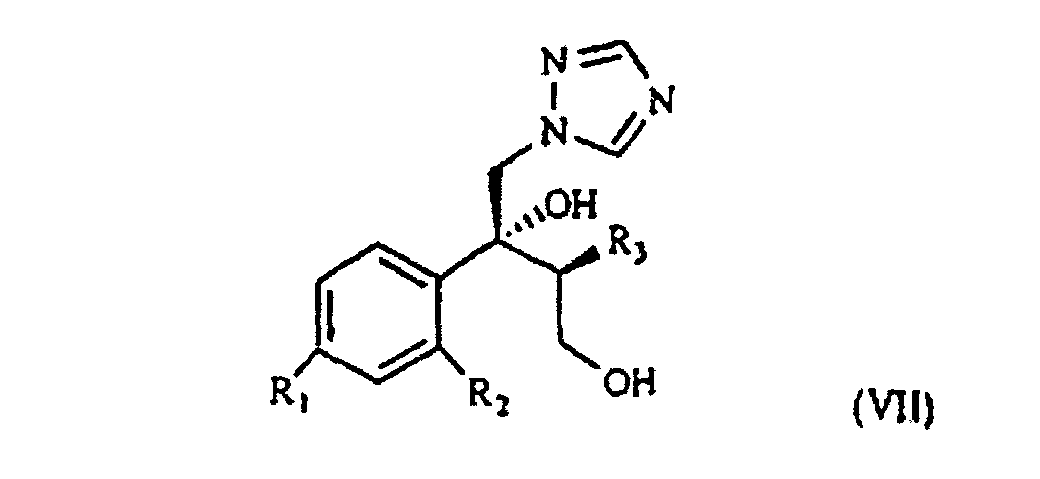
selon laquelle R1 est du chlore, du fluor ou du trifluorométhyle ;
R2 est de l'hydrogène, du chlore, du fluor, ou du trifluorométhyle ;
R3 est un alkyle C1-4, caractérisé en ce qu'une oléfine de formule II
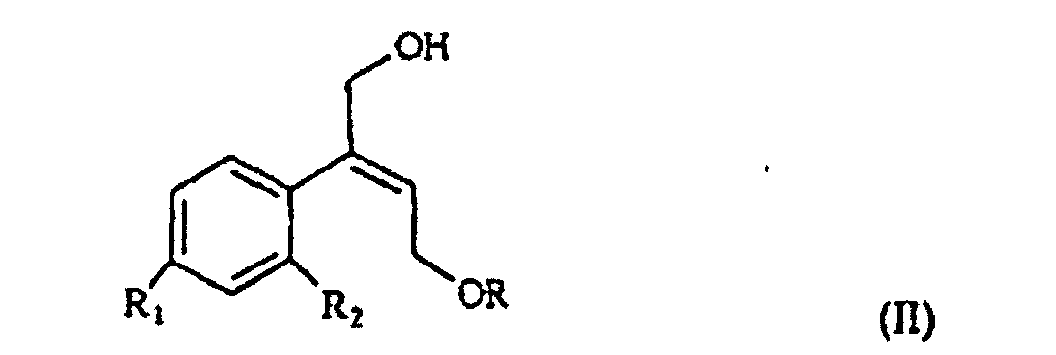
selon laquelle R1 et R2 sont tels que définis précédemment, et R est un hydrogène ou un groupe protecteur à fraction hydroxy, est époxydée pour obtenir l'oxirane de formule III

selon laquelle R, R1 et R2 sont tels que définis précédemment, qui lorsque traité avec de l'halogénure d'alkyl-magnésium (C1-4) en présence d'iodure de cuivre(I) permet d'obtenir un triol de formule IV
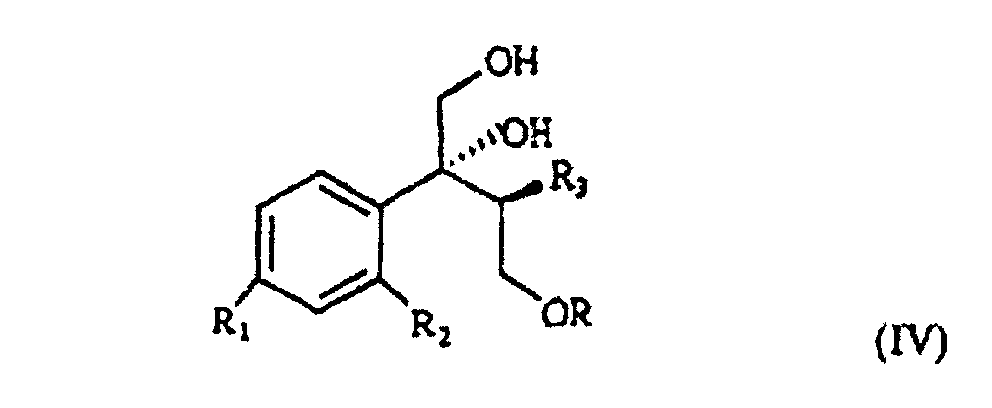
selon laquelle R, R1, R2 et R3 sont tels que définis précédemment ; et caractérisé en ce que le triol de formule IV est traité avec du chlorure d'acide sulfonique ou un agent halogénique, ensuite avec une base forte, pour obtenir un composant de formule V

selon laquelle R1, R2 et R3 sont tels que définis précédemment, et Lg est un halogène ou un groupe OSO2Riv, où Riv est un groupe alkyle C1-4 ou éventuellement un groupe phényle substitué par du méthyle, qui se trouve soumis à une réaction servant à substituer le groupe sortant Lg pour obtenir le composant de formule VI

selon laquelle R1, R2 et R3 sont tels que définis précédemment, qui se trouve traité par du 1,2,4-triazole en milieu de base pour obtenir le composant de formule VII.
selon laquelle R1 est du chlore, du fluor ou du trifluorométhyle ;
R2 est de l'hydrogène, du chlore, du fluor, ou du trifluorométhyle ;
R3 est un alkyle C1-4, caractérisé en ce qu'une oléfine de formule II
selon laquelle R1 et R2 sont tels que définis précédemment, et R est un hydrogène ou un groupe protecteur à fraction hydroxy, est époxydée pour obtenir l'oxirane de formule III
selon laquelle R, R1 et R2 sont tels que définis précédemment, qui lorsque traité avec de l'halogénure d'alkyl-magnésium (C1-4) en présence d'iodure de cuivre(I) permet d'obtenir un triol de formule IV
selon laquelle R, R1, R2 et R3 sont tels que définis précédemment ; et caractérisé en ce que le triol de formule IV est traité avec du chlorure d'acide sulfonique ou un agent halogénique, ensuite avec une base forte, pour obtenir un composant de formule V
selon laquelle R1, R2 et R3 sont tels que définis précédemment, et Lg est un halogène ou un groupe OSO2Riv, où Riv est un groupe alkyle C1-4 ou éventuellement un groupe phényle substitué par du méthyle, qui se trouve soumis à une réaction servant à substituer le groupe sortant Lg pour obtenir le composant de formule VI
selon laquelle R1, R2 et R3 sont tels que définis précédemment, qui se trouve traité par du 1,2,4-triazole en milieu de base pour obtenir le composant de formule VII.
2. Procédé pour la préparation d'un composé de formule I

selon laquelle R1 est du chlore, du fluor ou du trifluorométhyle ;
R2 est de l'hydrogène, du chlore, du fluor ou de trifluorométhyle ;
R est un alkyle C1-4 ; et
R4 est un groupe polyfluoroalkyle C1-5 contenant au moins deux atomes de fluor et éventuellement d'autres atomes d'halogène choisis à partir du chlore et du brome ;
et leurs sels d'acide acceptables d'un point de vue pharmaceutique, caractérisé ce que l'oléfine de formule II

selon laquelle R1 et R2 sont tels que définis à la revendication 1, et R est de l'hydrogène ou un groupe protecteur à fraction halogène, est époxydée pour obtenir l'oxirane de formule III
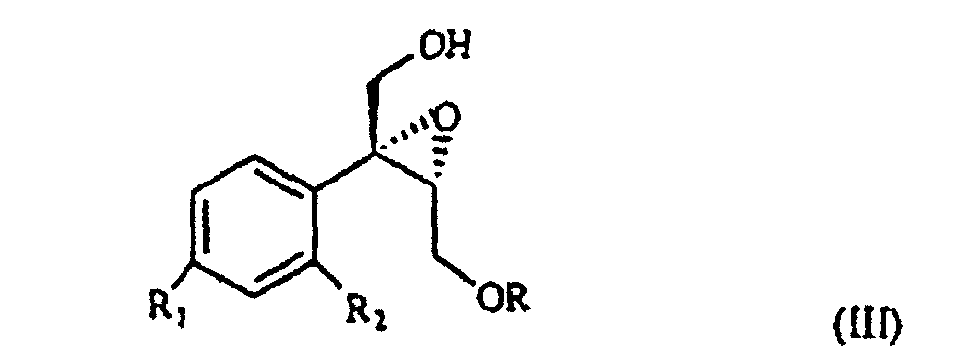
selon laquelle R, R1 et R2 sont tels que définis à la revendication 1, qui est traité avec un halogénure d'alkyl-magnésium (C1-4) en présence d'iodure de cuivre (I) pour obtenir le triol de formule IV
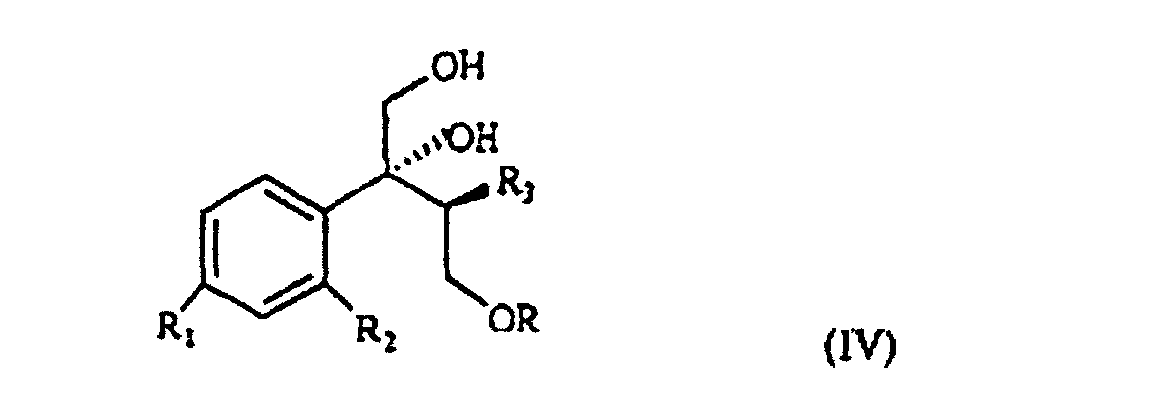
selon laquelle R, R1, R2 et R3 sont tels que définis à la revendication 1, et caractérisé en ce que le triol de formule IV est traité avec du chlorure d'acide sulfonique ou avec un agent halogénique, et ensuite avec une base forte, pour obtenir le composant de formule V

selon laquelle R1, R2 et R3 sont tels que définis à la revendication 1, et 1g est un halogène ou un groupe OSO2Riv où Riv est un groupe alkyle C1-4 ou un groupe phényle substitué par du méthyle, qui est soumis à une réaction servant à substituer le groupe Lg sortant pour obtenir le composant de formule VI

selon laquelle R1, R2 et R3 sont tels que définis à la revendication 1, qui est traité avec du 1,2,4-triazole en milieu de base pour obtenir le composant de formule VII
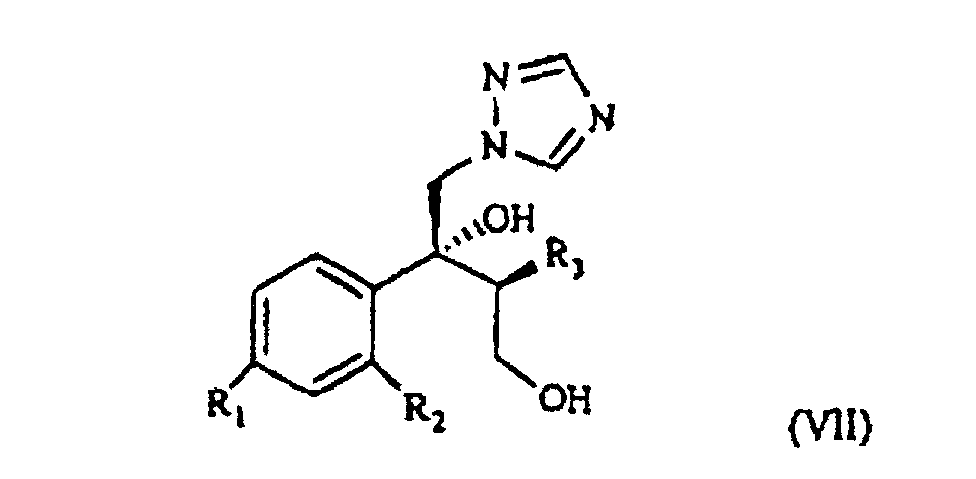
selon laquelle R1, R2 et R3 sont tels que définis à la revendication 1, qui se trouve réactivé avec un dérivé polyfluoroalkyle convenable.
selon laquelle R1 est du chlore, du fluor ou du trifluorométhyle ;
R2 est de l'hydrogène, du chlore, du fluor ou de trifluorométhyle ;
R est un alkyle C1-4 ; et
R4 est un groupe polyfluoroalkyle C1-5 contenant au moins deux atomes de fluor et éventuellement d'autres atomes d'halogène choisis à partir du chlore et du brome ;
et leurs sels d'acide acceptables d'un point de vue pharmaceutique, caractérisé ce que l'oléfine de formule II
selon laquelle R1 et R2 sont tels que définis à la revendication 1, et R est de l'hydrogène ou un groupe protecteur à fraction halogène, est époxydée pour obtenir l'oxirane de formule III
selon laquelle R, R1 et R2 sont tels que définis à la revendication 1, qui est traité avec un halogénure d'alkyl-magnésium (C1-4) en présence d'iodure de cuivre (I) pour obtenir le triol de formule IV
selon laquelle R, R1, R2 et R3 sont tels que définis à la revendication 1, et caractérisé en ce que le triol de formule IV est traité avec du chlorure d'acide sulfonique ou avec un agent halogénique, et ensuite avec une base forte, pour obtenir le composant de formule V
selon laquelle R1, R2 et R3 sont tels que définis à la revendication 1, et 1g est un halogène ou un groupe OSO2Riv où Riv est un groupe alkyle C1-4 ou un groupe phényle substitué par du méthyle, qui est soumis à une réaction servant à substituer le groupe Lg sortant pour obtenir le composant de formule VI
selon laquelle R1, R2 et R3 sont tels que définis à la revendication 1, qui est traité avec du 1,2,4-triazole en milieu de base pour obtenir le composant de formule VII
selon laquelle R1, R2 et R3 sont tels que définis à la revendication 1, qui se trouve réactivé avec un dérivé polyfluoroalkyle convenable.
